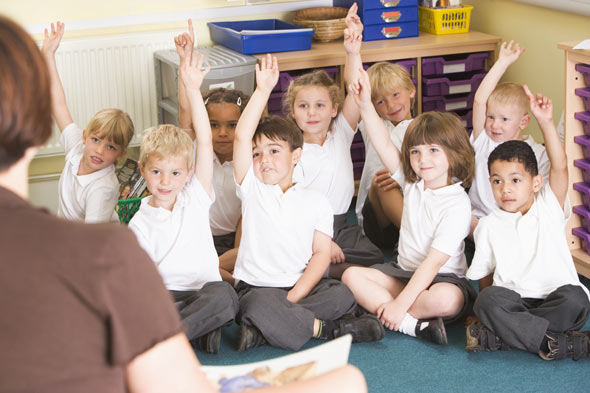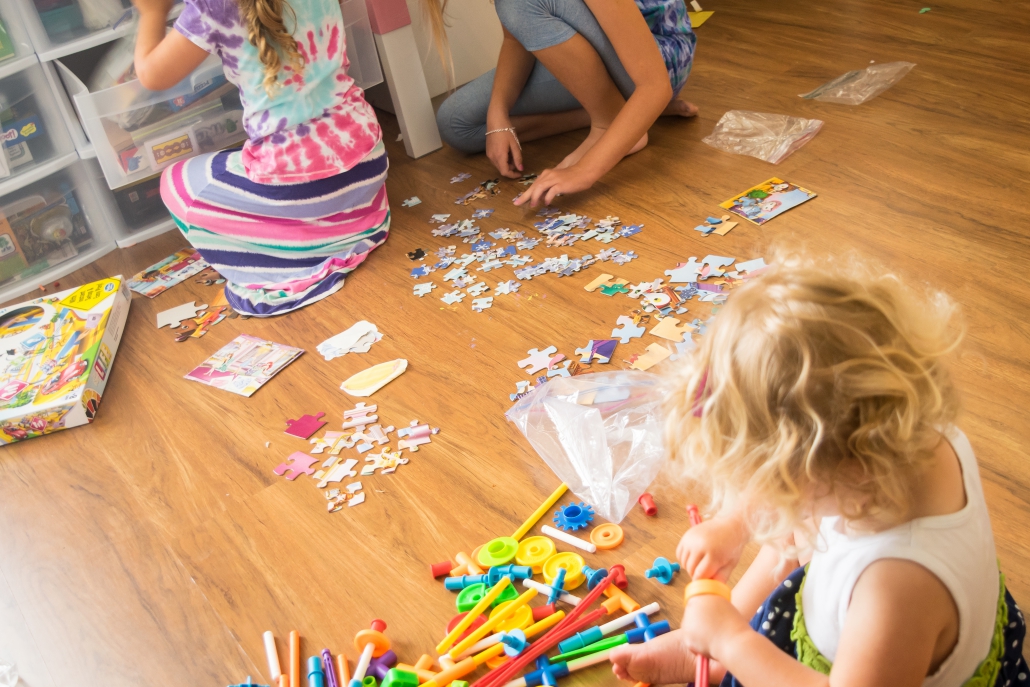Is my child really school ready? A guide to expected communication levels for school starters
by Elliot Agro on Sep 13, 2016

It’s exciting to send your little one off in their uniform for the first time, but when your child starts primary school it can also feel bittersweet. You can make sure they are prepared with everything they need: new uniform, check; shoes, check; lunch-box, check; labelled P.E kit, check. But how can you make sure they are prepared in terms of their communication skills?
Do communication skills matter?
Let’s think about this for a minute.
There are countless situations throughout the school day when your little one needs to use their very best speech and language skills to communicate with other children and with staff.
Let me give you an example, how will they let staff know when they need the toilet? How will your child communicate that they are thirsty? Or upset? On the other side of things, will the staff understand when your child is sad and needs reassurance? Parents often only need to glance at their child to know exactly what they need – it is not always as clear to those getting to know them for the first time.
But, don’t worry! – I’ve got you covered. In this blog, I will discuss five key stages of communication alongside information about how typically developing four-year-old should present and then give some tips on how to develop their skills. Remember, though, this is a guideline, not a definitive checklist. If your child is a little bit behind in some areas I will give you some actionable suggestions of how to support them.
Attention & listening
We all know that our little darlings can appear to develop selective listening from time to time, regardless of their age. Hey… I’m not apologising for the several times I have switched off during in-depth explanations of the offside rule. The question is, what levels of attention do our children need to be at when they begin school?
According to research conducted by Cooper, Moodley and Reynell (1978) a child of four years of age should be moving from “single channelled attention” to more “integrated attention”. This means they should be able to listen to verbal instructions whilst continuing to partake in an activity. Children also begin to develop their ability to listen to an instruction without needing to look at the speaker. Automated video transcription may be a great help in the classroom as well.
By school age a child should be able to follow adult directed games and requests and remain at an activity for at least ten minutes.
Why are these skills needed for the classroom?
Here’s a couple of reasons:
- Listening to and following requests directed towards the whole group such as “tidy up time”, “boys queue up next to the door”, “circle time”. When children do not respond it may seem as though they are being “naughty” by not doing as they are told.
- Listening to instructions and questions that are directed towards them e.g “George, it’s time to go home”.
- Remaining at an activity of their choosing for more than ten minutes without being distracted by other activities/toys in the classroom.
“Attention skills are the foundation of language learning. If a child is unable to attend to vocabulary then they will have difficulties understanding it and ultimately difficulties using it correctly”
What can a parent do to help?
- Ensure that your child has had an up to date hearing screen. Consult your local GP for a referral.
- Break down instructions into smaller, more manageable chunks.
- Repeat keywords.
- Use a gentle touch and call their name.
- Get down to the child’s level and ensure you are in their field of vision when speaking to them.
- Use visual resources such as sand-timers, visual timetables, now/next boards.
Social Communication
Of course, friendship fall-outs and break-ups are a right of passage for most children throughout their school experience. However, it is important our children have the correct set of social tools to begin with in order to cope with these social scenarios and ultimately become successful communicators.
So here it is, by the time a child begins school they should have consistent eye contact. They should have a good understanding of non-verbal communication e.g facial expressions and tone of voice and how they link to emotions.
“School starters should be able to initiate conversations with peers and adults and begin to accept the needs of others; taking into account what others say”
Many children show a good understanding of conversational rules such as:
- Talking about the same the topic everyone else is speaking about.
- Taking turns to ask and answer questions.
- Children beginning school also develop the social skills to resolve conflicts with other children without the need of immediate adult assistance e.g no longer arguing about who can play with a particular toy
- Learning to compromise.
Why are these skills needed for the classroom?
- Making friendships
- Taking turns in games – learning about winning and losing
- Sharing the classroom and it’s contents with others. For example, some children may become very possessive of a certain chair or pencil.
- Understanding social situations such as not talking when the teacher is talking, eating lunch in the main hall, sitting well in assemblies.
What can a parent do to help?
- Use visual support to help structure the daily routine such as a visual timetable.
- Give specific praise for appropriate social skills e.g “that was really good looking”, “I liked how you shared your pencils with Johnny”.
- In everyday situations talk about the differences in what people like and think.
- Discuss the facial expressions of characters in books and films.
Level of understanding
As a parent, it can often seem that your child’s understanding is “fine”. They follow the majority of your instructions without an issue. But let’s dig a little deeper….
Children are intelligent, resourceful creatures and they pick up on every hand gesture, finger point and direction of eye gaze. What I mean by this is that often when we give children instructions or ask questions we subconsciously provide them with non-verbal cues. In other words, they don’t need to understand the words we are saying….clever!! Of course there’s nothing wrong with using gestures when we speak, however we need to ensure that our children can follow the expected level of verbal understanding without help from us.
According to the charity iCan, by the time a child begins school he should be able to understand simple “who” “what” and “where” questions. They should also have a vocabulary knowledge in the thousands!
As a very general rule I would expect the following levels of understanding from a typically developing child between 0-4 years:
- 1 years - to follow single word instructions
E.g. where's teddy? - 2 years - to follow 2 key word instructions
E.g. Give teddy cake - 3 years - to follow 3 key word instructions
E.g. Put cake on teddy's plate - 4 years - to follow 4 key word instructions
E.g. Put cake on teddy's blue plate
What can a parent do to help?
In a classroom teachers give instructions all the time. They also introduce new words and ideas almost every day. What can you do to help?
- Break down large amounts of information into smaller, more manageable chunks.
- Repeat key points.
- Ensure you are using the right level of language for your child.
- Try to build your child’s vocabulary knowledge by providing them with a wide range of opportunities to understand shape, colour, texture as well as naming objects and verbs.
Use of language
As parents, one of our biggest fears is that our child is unable to make their wants and needs understood. Once they begin full-time education, we won’t be there to help them communicate and translate for them.
According to the Early Years Foundation Stage (EYFS) guidelines set by the UK government, a child starting school should be beginning to use more complex sentences which reflect their growing vocabulary knowledge. By the age of 4 your child should also be connecting their ideas and thoughts using words such as “and” and “because”, for example, “I hurt my knee because I falled over.” School starters should be able to recall a past event and use a range of tenses, however, these may not yet be used accurately.
Confidence in communicating with others can have a large impact on how our children use language, and conversing with unfamiliar adults may be difficult for some children.
Why are these skills needed for the classroom?
- Explaining their wants and needs coherently.
- Interacting successfully with peers.
- Developing imaginary play skills by commenting on their play.
- Recalling past activities e.g what they did over the weekend.
- Explaining what happened e.g how did they get that bruise on their leg?
- Telling the teacher when they don’t understand and being able to ask for help.
What can a parent do to help?
- Give your child extra time to express themselves and try not to interrupt.
- Create communicative opportunities e.g give your child only paper and no crayons, place items high up on shelves, give a knife and no fork.
- Try not to anticipate your child’s needs before they have had chance to ask.
- Prompt them with sequencing words such as and, then, next, last.
- Use visual aids to help conversation with your child e.g. photos, picture books, objects.
- Model the the correct sentence structure and grammar e.g. “him falled down them”, “yes he’s fallen down the steps”
- Give your child specific praise when they demonstrate good talking e.g “Spencer you used a really long sentence then. Well done”.
Speech Sounds
When a child enters primary school their speech sounds are still developing so don’t worry too much if their talking isn’t perfect. Let’s have a look at this table. It shows the age at which individual speech sounds develop and which sounds should be firmly in place by school age.
90% of children will be using these sounds by the following ages:
3 years - p b m n t d w k g f h y
4 years - ng s
5 years - l
6 years sh ch j z v r + clusters e.g. br, cr, st etc
By 4 years of age your child should have also stopped using the following speech sound processes which are developmental:
- Missing off the ends of words e.g “car” is “ca”
- Sounds made at the back of the mouth (k and/or g) are made at the front of the mouth (t and/or d) e.g “garden” is “darden” and “cow” is “tow”.
- A long sound e.g “s” is replaced by a long sound e.g “t”, for example “sun” becomes “tun”.
Why are these skills needed for the classroom?
- If a child is unable to make themselves understood this may impact upon their ability to interact with peers and can therefore impact on communicative confidence.
- Understanding the difference in sounds is important for phonics.
What can a parent do to help?
- Model the correct production of a word for your child. Instead of directly correcting them, repeat back what they have said but with the correct sounds. For example “it’s a boo tar”, “Yes Grace, it’s a blue car!” This helps keep the child’s confidence in communicating.
- Always be positive about your child’s speech.
- Don’t force them to produce target sounds – this may cause frustration and upset.
I hope you have found this blog post helpful. As I said at the beginning of the article, every child develops at different rates and show individual strengths and challenges.
- General mental health (35)
- General Speech & Language (32)
- School Issues (26)
- Counselling (24)
- Primary Schools (24)
- Classroom Behaviour (23)
- Anxiety (22)
- Speech and Language Therapy (22)
- Absenteeism (20)
- SENCOs (20)
- Safeguarding (17)
- Secondary & Sixth Form Schools (16)
- Social Communication (16)
- Funding (14)
- MATs (14)
- Generalised anxiety (13)
- Autism Support (10)
- Language Delay/Disorder (10)
- Relationship Issues (10)
- SEMH (10)
- ADHD Support (7)
- Speech Sounds (7)
- AAC (6)
- Autism (5)
- Hearing Impairment (5)
- Depression (4)
- Selective Mutism (4)
- Anger (3)
- Cleft Lip/Palate (3)
- Downs Syndrome (2)
- Ofsted (2)
- Phobias (2)
- Stammering (2)
- Loss (1)
- Self-Harm (1)
- Suicidal Thoughts (1)
You may also like
These related stories

Supporting speech and language development during lockdown

My child mispronounces words – how can I help them?
